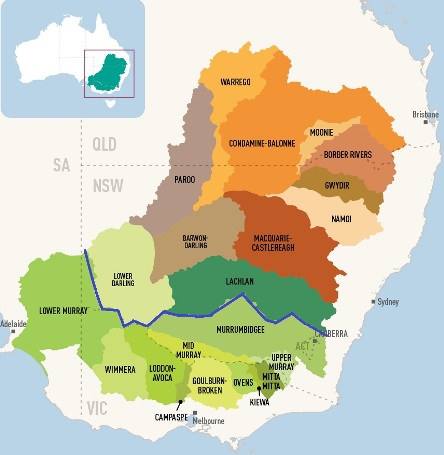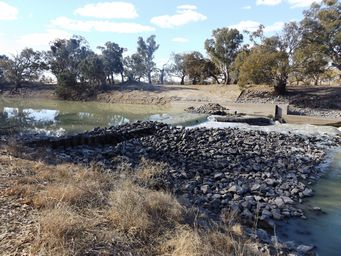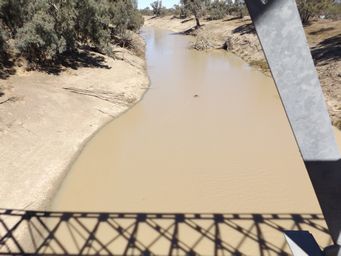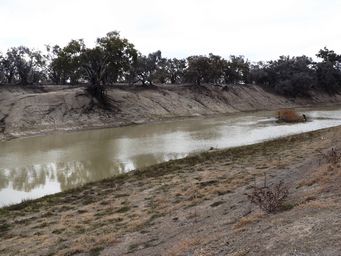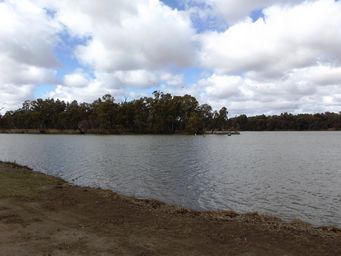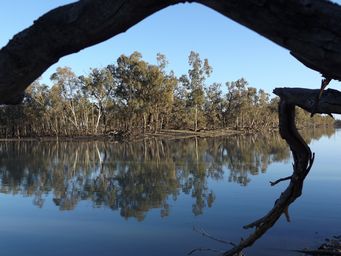New South Wales - Darling River Run Tilpa to Wilcannia
Australia So Much to See
In addition to the National Parks campgrounds at Toorale and Gundabooka as per this page, there are a number of station stays, including Rose Isle Farmstay near the Gundabooka national park and accessed from the south side of the river.
At Louth there
is camping at Shindy’s Inn #, and those self sufficient can camp at the Common on the west side of the bridge. Toilets
and hot showers adjacent to the park opposite the hotel for a donation to RFDS which can be left at the hotel (when open).
# Camping at Hotel closed during 2020 and their website no longer works. Camping re-opened mid 2023. Facebook page only with website still not available.
On the north west side, Station Stays at Dunlop, Trilby and Kallara stations are alongside the river between Louth and Tilpa.
The tiny town of Tilpa has a small caravan parking area at no charge, but toilets
and showers in the town have subsequently been closed to campers due to misuse.
Unserviced free camping at Tilpa Weir, seven
kilometres by road north east of the town when accessed from the southern side of the river. The northern side of the weir can
also be accessed.
In the Paroo-Darling National Park, Coach and Horses campground is on the southern side of
the river.
Update: Due to Covid restrictions, since June 2020, all national parks camping must be booked, online via NSW National Parks or by phone on 1300 072 757. A $6 booking fee applies to all bookings, even for campgrounds that do not charge a camping fee.
Victory Caravan Park in Wilcannia is also on the river, south side, being across the river from the main town area.
Consisting of scattered waterholes in drought times, the river can be eighty kilometres wide in places when in flood.
Once the
major transport route through western New South Wales, by the 1890s, about 40,000 bales of wool were shipped down the Darling River
each year, and approximately 100 paddle steamers and barges worked the river.
Saline interception. At Jandra Station,
seventy kilometres north east of Louth, a large-scale groundwater pumping project intercepts and prevents deep channel saline inflows
from entering the Darling River. This is evaporated in claypans. The Department of Water and Energy asses that approximately
thirty tonnes of salt a week are prevented from entering the Darling River.
While salinity has increased with agriculture
in the area, salinity is not new. Explorer Charles Sturt at first named the Darling ‘Salt River’.
We had basically
followed the Darling River from where it begins at the junction of Barwon and Culgoa Rivers as near as you can get using main roads,
through Bourke and on to Wilcannia. The Bogan River joins the Barwon just prior to this point. We crossed the Darling
at North Bourke, and took a riverboat cruise on the Darling.
On our 2004 trip, we followed the river on a good clay road on the south
eastern side from Bourke to meet the Barrier Highway seven kilometres south of Wilcannia. This road had occasional glimpses
of the river, and numerous tracks running to the river. This trip pre-dates digital photographs.
In 2017 we took
the north western side from Louth.
The road, while mostly wide, was variable and there were many narrow raised stock grids
at regular intervals as we travelled though pastoral stations. Without visiting a station farm stay, the river was not accessible. The Wilcannia end of this road was in poor condition at this time.
We did not take the roads, which are both sides, following
the river from Wilcannia to Wentworth, instead visiting the Darling River again at Menindee.
We did stop along the Great
Anabranch of the Darling, being the ancestral part of the Darling River. This deviates from the present Darling River
in Kinchega National Park, to the south of Menindee then swings west from the to join the Murray River around eight kilometres west
of Wentworth.
Darling River has always been called Baaka by Barkindji people. It is the third longest river in Australia at 1,472 kilometres
from its commencement between Brewarrina and Bourke to its confluence with the Murray River at Wentworth. By road you will travel
between 700 and 800 kilometres.
The Darling River catchment covers one million square kilometres being 14% of Australia
and is the largest river system in Australia.
Map at right from Murray-Darling Basin Authority, on which I have marked a blue
line roughly differentiating the northern (Darling River) catchments from the southern (Murray River) tributaries.
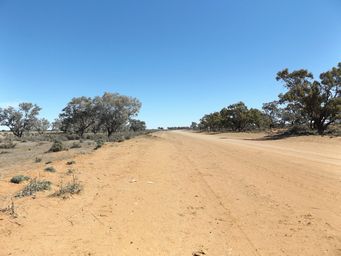
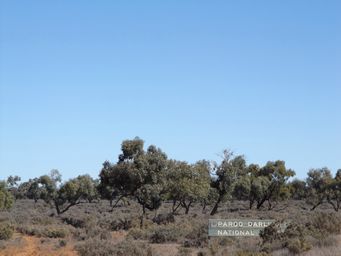
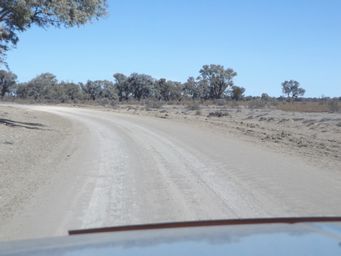
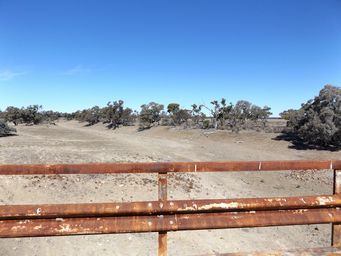

We entered from the north via Reid Street, and saw heritage buildings such as the Council Chambers and the Post Office. Wilcannia
has lovely old sandstone buildings built during the 1800s, but due to our time frame I did not take any photos of these.
Some
of these are:
Wilcannia Hospital which was originally built in 1879, was built of locally quarried white quartzite sandstone,
to a symmetrical cruciform plan. its major function was servicing the needs of riverboat traffic passing Wilcannia. Commencing
in 1998, the hospital was redeveloped and expanded, retaining as much of the original building as possible. The original hospital
contains administration offices, ancillary spaces and consulting rooms.
Post Office and post master’s residence 1880. For around 15 years, post office services were run from a shopping complex, however this original post office was restored and the
postal services returned to the heritage building around 2014.
Courthouse 1880 and Police station 1881, which were first
built as a goal.
The Wilcannia Athenaeum is a heritage listed, rusticated sandstone building in the town of Wilcannia,
New South Wales. Built in 1883 in Reid Street, the Athenaeum was established to be an institution for community education, a school
of arts and included a public library. It has served a number of functions including as a social centre, a library, a newspaper office,
a municipal council meeting place, the Wilcannia Telecentre and is now a museum.
St James Anglican Church 1883. The foundation
stone for St James church was laid in 1875, and the
building finally consecrated in 1883. This lovely sandstone church has a
detached iron framed memorial bell tower in memory of Private R A Lachie, erected by his family after WW1.
Council Chambers
building was erected in 1887 for the London Chartered Bank of Australia. It features elaborate wrought iron work on the balcony.
From here we follow the West Tilpa Road.
Roads on this side do not give glimpses of the river itself, apart from at the two small riverside towns of Louth and Tilpa, where bridges cross the river. See previous pages.
Station stays have camping along the river.
Nearer Wilcannia we drove through the southern section of the Paroo-Darling National Park. Crossing the Paroo River bed above
right. Usually the Paroo River terminates on the floodplain south of Wanaaring; and only reaches the Darling River in the wettest
of years.
At Wilcannia we meet the Barrier Highway. The Barrier Highway crosses the Darling River on the south east side of town, and
this time, we were entering from the north side of the river so did not cross it. The current highway bridge is alongside the
now closed centre lift span bridge, in a similar style to the bridges at Brewarrina and Bourke. Unlike Bourke, the Wilcannia
bridge is open for foot traffic, and forms part of a walkway. I photographed this lovely bridge in 2004 which was pre digital
photography.
Completed in 1896, this was the first bridge crossing the Darling River between Wentworth and Bourke. The
North Bourke bridge was constructed in 1983, and the Brewarrina bridge in 1988. This bridge is a classic example of the vertical lift
spa bridges that were built through western New South Wales navigable rivers in that period. Designed by J.A. McDonald, the
centre spam lifts vertically on wire ropes balanced by counterweights. This National Trust listed bridge is one of only a few
remaining examples of the 23 moveable bridges built on the Murray-Darling river system.
Prior to its construction, all
stock and vehicular traffic crossed by punt, although occasionally larger herd of cattle swum across the river.
In late
January 1859 Captain Francis Cadell in charge of the Albury steamer entered the Darling River at its junction with the Murray, and
after eight days he reached the 'Mount Murchison' pastoral run. Cadell's pioneering journey was the beginning of steamer transportation
on the Darling River. The site of the future township developed as the location for the unloading and loading of cargo. The settlement
was initially known as Mount Murchison, taking its name from the nearby pastoral run. As economic activity increased the location
attracted business and trades providing services and amenities to the surrounding stations. The town was established in 1866
as Wilcannia, but the name of Mount Murchison persisted for some time. The name of Wilcannia is from the Aboriginal name for the area,
with "a gap in the bank where the flood waters escape" being the most commonly accepted meaning. The port at Wilcannia was the
third largest on the Darling River, exporting mainly wheat and wool.
